The Definitive Sennheiser E945 review
The dynamic vocal microphone with it all – pristine sound with superior feedback and side rejection
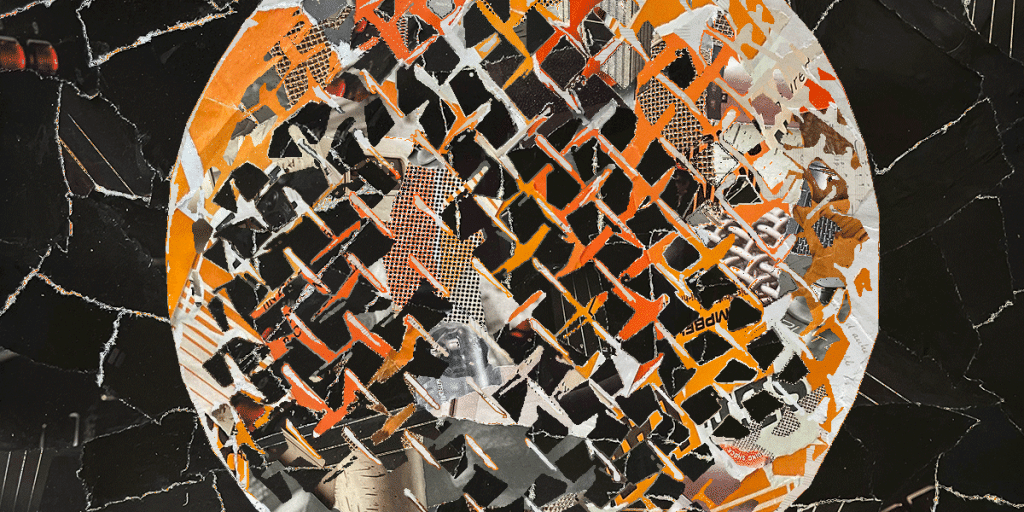
Reviewed by: Paul Narang
Review date: August 2022
Price: Under $200
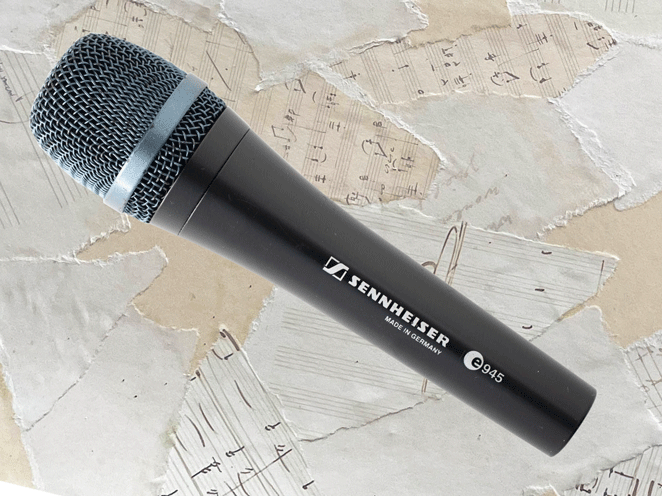

Sennheiser E945 Review
| Pros: | Cons: |
| Picks up only the voice Beautifully clear and detailed sound Solid construction | Sensitive to plosives and sibilance |
Sennheiser E945 Review
An extended range dynamic vocal mic with a tight supercardioid pickup pattern. Ideal for live use on a noisy stage where the vocals really need to cut through.
What is it?
Sennheiser have a history of manufacturing some of the best microphones in the world. They’re used by professionals in live music and throughout the world’s top recording studios.
Sennheiser’s Evolution 900 series are an elite microphone range, serving professional vocalists and musicians on the live stage. This collection of harmonically calibrated mics include three specifically designed for vocalists:
- Sennheiser E935 cardioid dynamic
- Sennheiser E945 supercardioid dynamic (reviewed here)
- Sennheiser E965 condenser
The E 945 is a beautifully designed mic, with a rugged metal body. It has a supercardioid pickup pattern, which cuts out any unwanted sound from the sides of the mic. See how it performs in our Sennheiser E945 review.
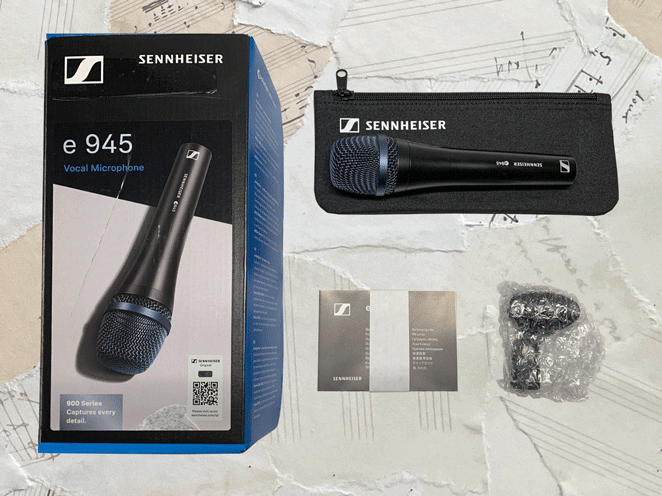
In the box
The Sennheiser E945 mic arrived in a smart blue, grey and white cardboard box which also included:
- microphone clamp
- Zip up microphone pouch
- User manual
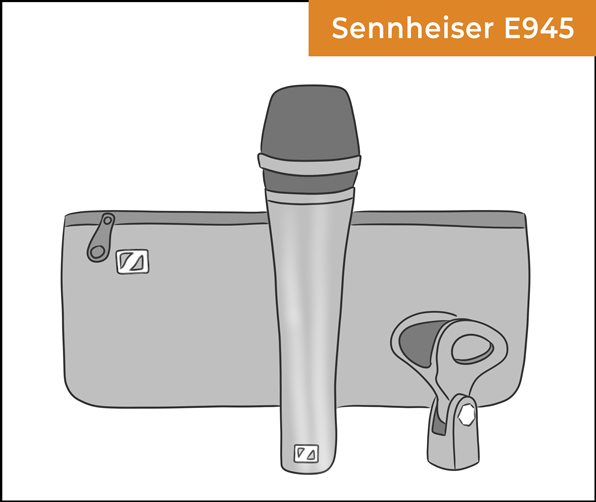
Dynamic vs condenser microphone
The Sennheiser E 945 is a ‘dynamic’ microphone. Dynamic microphones differ to ‘condenser’ microphones in the following ways:
- They’re less sensitive
- They’re less prone to feedback
- They’re more rugged and durable for live use
- They’re cheaper
- You can plug and play without power
E945 Polar pattern
The Sennheiser E 945 dynamic vocal mic has a supercardioid pickup pattern, which is tighter than the more common heart-shaped, cardioid polar pattern. It picks up a band of sound from the front, as well as a narrower band from the back. Sound is rejected from the back and sides. This makes it ideal for use on stage, where you can really isolate the vocals from other noisy instruments, and minimise feedback.
It’s also great for the studio when you have 2 or more singers or instrumentalists recording at the same time.


A standard cardioid pattern is ideal for a home studio where the acoustics of the room are less than ideal. It picks up the sound of the vocalist in front of the mic, while rejecting most of the reflections coming from the room.
This is emphasised even more with a supercardioid like the E945. And being a dynamic mic, it will pick up less of those distant sounds, like traffic rumble or noisy neighbours.
A note of caution – a mic with a super-cardioid polar pattern also picks up a small amount of sound from behind. So it’s important to be aware of what’s directly behind you.
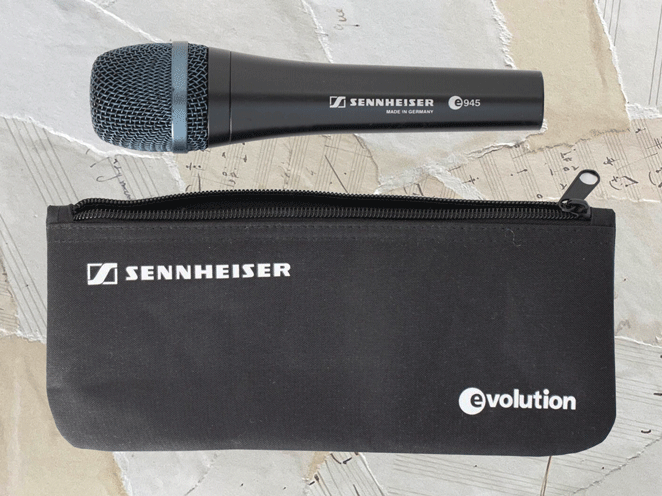
No on/off switch on the E 945?
None of the mics from Sennheiser’s 900 series have on-off switches. This is probably an intentional design of the E945, to minimise the chances of anything going wrong during live performance. If you need to be able to switch your microphone on and off, take a look at the E845 S, from the 800 series.
Phantom power for the Sennheiser E945?
The E945 is a dynamic mic, which means it doesn’t require any form of external power. There’s no need for batteries, or ‘phantom power’ from the audio interface or mixer.
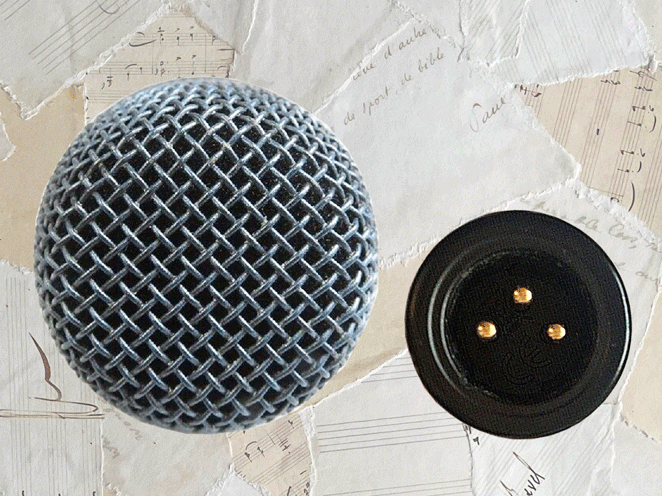
Connecting the Sennheiser E945
The E945 uses an XLR cable to connect directly to an audio interface or mixer. XLR cables are ‘balanced’, which means the cables are shielded from interference and carry a higher signal than unbalanced cables.
If your audio interface or mixer has 1/4″ jack inputs, you’ll need a cable with an XLR connector on one end, and a 1/4″ jack on the other, like this. Keeping cable lengths to a minimum is good practice to maintain the best signal.
The Sennheiser E945 Design and build
The Sennheiser E 945 dynamic vocal mic is built like a tank. Holding one of these inspires confidence. The simple, straightforward design ensures there isn’t much that could go wrong during a live performance or studio session.
Like the other vocal mics in the Evolution range, the E 945 is a good looking microphone with a slender minimal design. It has a substantial weight at 365g (0.8 lb), and a diameter of 46 mm (1.85″). The length is 186 mm (7.32″) – 3.5 cm longer than the E935, and around 2.5 cm taller than the Shure SM58.
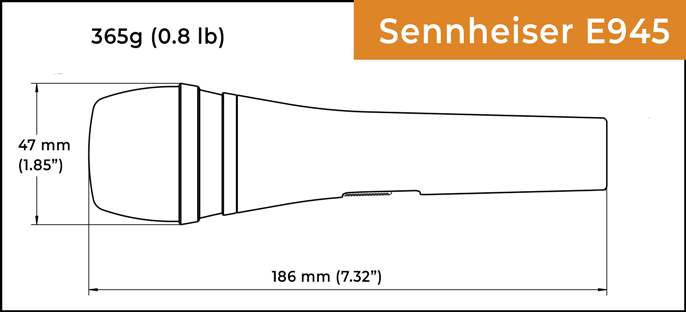
Reassuringly solid, the main dark grey body is made of metal, and there’s a strong blue/black metal grille protecting the top. The grille can be unscrewed, so that the foam insert can be removed for cleaning or replacing.
Inside the mic is a humbucking coil, which effectively cancels electromagnetic hum, ensuring a clean signal. An elastic capsule suspension isolates handling noise, so you can hold the mic with the confidence that it won’t interfere with the sound.
The E945 has a strong neodymium ferrous magnet which ensures microphone stability in temperatures between 0° and 40° Centigrade.
It also comes with an industry leading 10 year warranty.
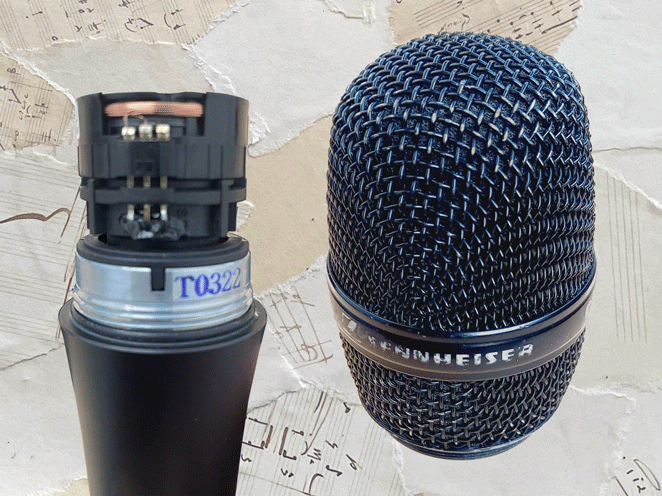
Sennheiser E945 Frequency range
The E 945 dynamic mic has a stated frequency response of 40 Hz to 18 kHz. This is a wide range, suitable for both male and female vocals or speech.
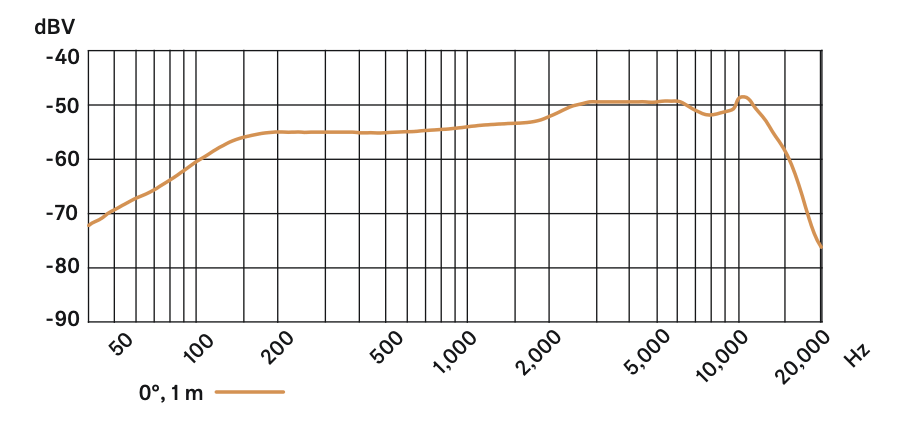
The frequency chart shows the E945 mic to have a steady rise between 150 Hz and 2 kHz, followed by a a few decibels boost until 6 kHz. At 6 kHz, there’s a sudden dip, before a narrow peak at 10 kHz.
Compared with the E935 frequency chart, it’s less smooth. But although less smooth than it’s cardioid sibling, the peak at 10 kHz really gives this mic the edge for cutting through a busy mix.
E945 Sensitivity and impedance
As a dynamic mic, the Sennheiser E 945 has less sensitivity than a condenser mic. Low sensitivity is great for isolating the sound being picked up, as well as making it ideal for loud sound sources.
Like most professional microphones, it has a low output impedance, stated as a nominal impedance of 350 ohms. This makes it a good performer across long cable runs, and less susceptible to external interference.

E945 Sound quality
As the E945 is a supercardioid version of the cardioid E935, I wasn’t surprised that it had many of the same qualities. A neat, tamed low end is balanced by a clear and detailed higher range.
Like the E935, the E945 has that magic combination of being bright and open, but still warm and full. It delivers a natural sound which won’t need as much Eq as a warmer mic such as the Shure SM58.
I could hear subtleties and nuances from this mic which I would normally only hear while singing to myself in a quiet room. It’s a relaxing mic to use, where you don’t have to force your voice to get a big sound. It’s as if the microphone is doing the work for you.
The Sennheiser E945 dynamic mic is suited to both male and female voices. Female vocals benefit from a natural and subtle boost in the lower frequencies, while leaving plenty of space in the high frequencies. While deeper male vocals get a presence boost and sparkle to counteract the bass.
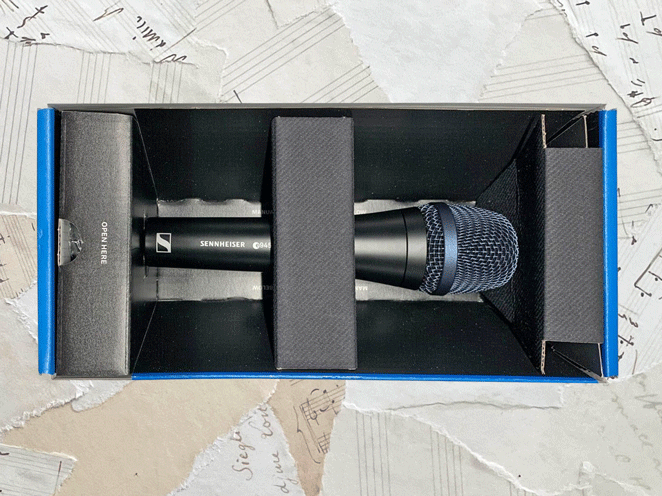
Sennheiser E945 in Performance
The Sennheiser E945 vocal dynamic mic has a supercardioid pick up pattern, making it an ideal choice for situations where rejecting erroneous noise is paramount. This makes it ideal for the stage and live performance with a band.
Having such a tight polar pattern also requires a specific microphone technique. You need to be positioned right in front of the mic, making sure not to stray too far, as you’ll hear this in the sound.
But once you get the hang of it, this sensitivity becomes an invaluable tool, as you find ways of getting extra subtleties and variations from small movements of the mic. It can really give you that performance edge.
The extra sensitivity of the E945 makes it more susceptible to plosives, those little bursts of air which cause deep popping sounds. Again, its microphone technique that can help with this – angling the mic very slightly to the side. You can also try using it with a windshield on stage, or with a pop shield in the studio.
It has good noise handling, so you can grip it and move it around with confidence. And feedback rejection is superior to many other vocal mics. The proximity effect is pronounced, so you can add extra bass to your sound when you need to be moving in close to the mic.
Sennheiser E945 vs Shure SM58
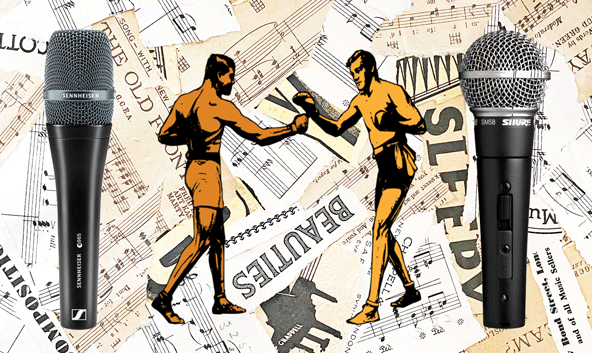
The Sennheiser E945 is a very different microphone to the Shure SM58. They’re both rugged metal dynamic vocal microphones, suited to live singing, but that’s where the similarities stop.
The E945 is an altogether more sophisticated and powerful mic. If you’re upgrading from an SM58, you’ll have to get used to more volume, more sensitivity and more clarity. It’s like trading a Toyota in for a Mercedes. The Toyota is a reliable workhorse, but once you’re in a Mercedes, you’ll have a lot more to play with.
While the Shure SM58 is a warm sounding mic, the Sennheiser E945 is open and bright. It reveals intricacies and details which the SM58 will gloss over, and help to push your vocals to the front of the mix.
Holding the E945
Where you hold the microphone in relation to your mouth can make a big difference in sound. Professional vocalists are always repositioning their mics to change the tone and add expression to their performance.
Always hold the vocal mic by the main body, and if there’s too much sibilance, try holding it slightly to the side.
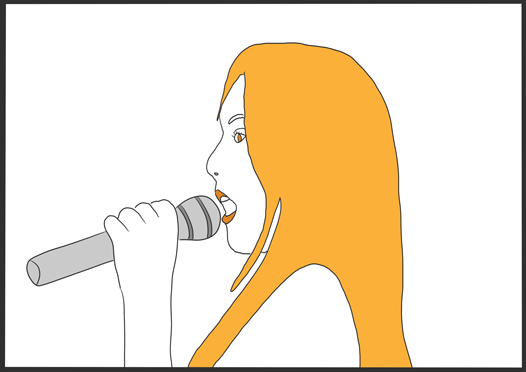
When you have other instruments in close proximity and you just want the sound of the voice, it’s best to sing or speak directly into the mic. This will add more bass to the sound, due to the ‘proximity effect’. It’s an effect used by radio presenters to give them very deep voices.

For a more natural, balanced sound, hold the mic between 5 and 10 cm away from your mouth. There’ll be less of the proximity effect, and the mic will pick up more sounds from other instruments, and the acoustics of the room.

To bring in more of the room sound, and the instruments around you, hold the mic 10 cm or more away from your mouth. This is also a good position for any sudden loud notes, or to shape, and tail off a long note.
Sennheiser E945 vs E935
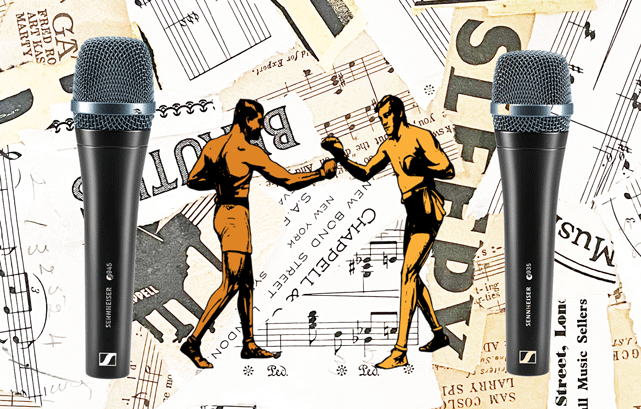
Also in Sennheiser’s Evolution range is the Sennheiser E935 dynamic vocal mic, which has similar sonic characteristics. The main difference is that the E935 has a cardioid pattern, whereas the E945 has a supercardioid pattern.
If you’re just looking for a mic for your recording studio, and your room has some acoustic treatment, you might want to also consider the E935. The cardioid pick up pattern of the E 935 will give the vocalist a little more flexibility to move around the mic without effecting the sound.
But if you sing live, and you’re struggling with feedback issues, or you’re picking up too much sound from the sides of you mic, the E 945 mic will give you a distinct advantage. The disadvantage is that you can’t move too far from the front of the microphone without affecting the sound quality.
Read the full Sennheiser E935 review here
Sennheiser E945 vs Shure Beta 58A
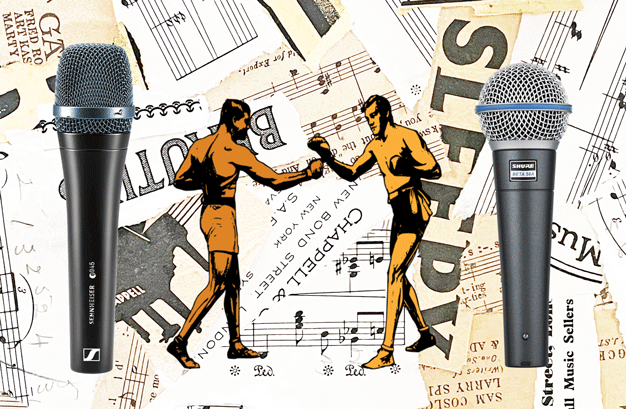
The Sennheiser E945 vocal microphone is often compared to the Shure Beta 58 A – a popular vocal mic, derived from the well known SM58. Both of these microphones are dynamic, and have supercardioid polar patterns.
The E945 and the Shure Beta 58A have many similarities. Both the Beta 58 and E945 have metal bodies, and internal shock mount and with excellent feedback rejection.
Despite the E 945 using a humbucker coil, and the Beta 58A, a single coil, they both have an upfront, bright sound. They’re both clear and detailed, with the ability to cut through a busy mix.
Every voice is different, and with these two mics, its about personal preference, and what sound you’re looking to create.
Something to consider is that the Sennheiser E 945 dynamic vocal mic comes with a 10 year manufacturer’s warranty, whereas the Shure Beta 58A only has 2 years. I wouldn’t give this too much weight in your decision though, as they’re both solidly built.
What else do you need?
With any vocal microphone, you’ll need:
- Microphone stand
Mic stands reduce any handling noise in the studio. Try a good quality boom stand, with a tripod base like the K&M 210/2
- XLR cable
If you want the best quality XLR cables, try these. Go for the shorter lengths where possible.
- Pop shield
This is to stop little bursts of air causing bassy pops on your studio recordings. You can easily make one of these out of stockings, or buy one here.
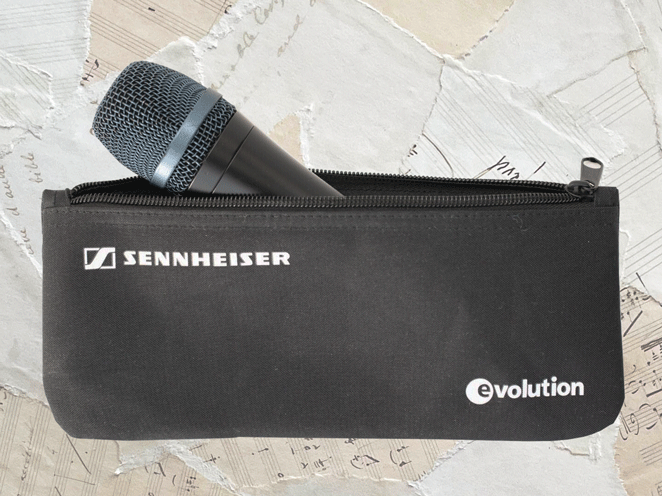
Conclusion
The Sennheiser E945 dynamic vocal mic is the perfect choice for live performance – it’s built like a tank, rejects noise from the side, and effectively fends off feedback.
It also has a use in the home recording studio, as the supercardioid capsule ensures that reflections from an untreated room won’t influence the sound. Its ability to handle high sound pressure levels, also makes it great with loud instruments, such as drums and brass.
The sound is balanced, with a bright revealing edge to show off all the intricacies and details of your voice. The Sennheiser E945 will lift your vocals above the sound of a busy band while still retaining warmth, detail and clarity.
Frequently Asked Questions
Is the Sennheiser E945 a vocal mic?
Yes, the E945 is primarily used for live vocals, but it’s also a good microphone for instruments when you need to focus in on a sound source.
What pick up pattern is the E945?
The Sennheiser E945 has a super-cardioid polar pattern, making it ideal for noise rejection to the sides of the mic.
How do I clean an E945 microphone?
Use a 70% alcohol solution sprayed onto a soft cloth to wipe down the body. To clean the head grille, twist it off, remove any foam and use a brush with 70% alcohol solution. Use warm water to clean the foam.
